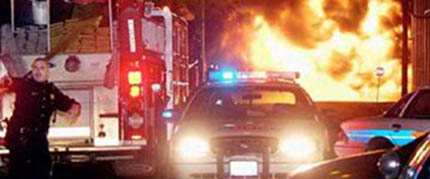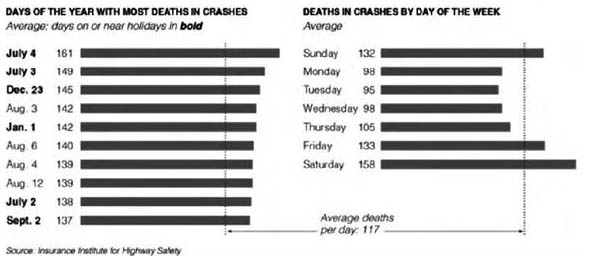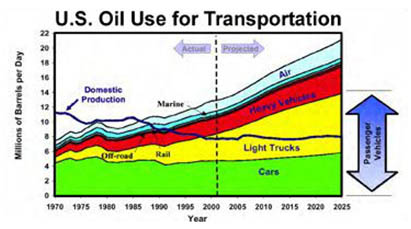

How Can the U.S. Can Ensure Its Energy and Economic Security
Step 1: The U.S. must start to act now to maintain affordable and effective transport
when oil peaks in the next 10-20 years. Not acting now will have serious
economic and social consequences.
Step 2: The U.S. should not assume that the “hydrogen economy” will solve the peak
oil problem for transport. (see American physical society report for full
discussion)
• Producing hydrogen for transport will require enormous amounts of
energy-either new electrical power plants or billions of tons/year of more
coal (making the equivalent of 2000 A.D. oil for transport would require
tripling U.S. electrical capacity).
• Major "show stopper": problems with hydrogen for transport---h2 filling
stations on every block; h2 leakage from auto tanks; crash safety?; fuel
cell cost?; weight of car tanks?
Step 3: The U.S. should focus on practical technologies that can meet the peak
oil challenge.
• Better fuel economy for autos and trucks.
• Electrification of rail and MAGLEV.
• Better synfuel processes based on coal and other abundant synfuel feedstocks.
Public Safety & Health
BRIDGEPORT, Friday, March 26, 2004 NYT- A tractor-trailer collided with a car on an elevated stretch of Interstate 95 here Thursday night, igniting a fire that caused part of the southbound roadway to buckle, officials said. The cave-in forced the closure of part of the road - the busiest highway in the Northeast - for at least two weeks, the authorities said.
Total Fatalities in Motor Vehicle Crashes by Type of Crash: 1998 
Drivers/occupants killed in single-vehicle crashes 16,671
Drivers/occupants killed in two-vehicle crashes 15,724
Drivers/occupants killed in more than two-vehicle crashes 2,964
Pedestrians killed in single-vehicle crashes 4,795
Bicyclists killed in single-vehicle crashes 737
Pedestrians/bicyclists killed in multiple-vehicle crashes 449
Others/unknown 131
Total 41,471
Source: U.S. Department of Transportation, National Highway Traffic Safety Administration, Traffic Safety Facts 1998 (Washington, DC: 1999).
The Cost of Highway Deaths & Injuries
• Highway accidents take a tremendous toll on society, both in lives and the quality of life for the injured, and also in economic terms.
• The economic cost of 40,000 fatalities and millions injured is 100’s of billions of dollars per year. A national MAGLEV system would greatly reduce highway
deaths and injuries.
• Cutting deaths and injuries in half would save over $100 billion per year - far more than the MAGLEV system would cost.
A new study of deaths in car crashes from 1975 to 2002 finds that while the Fourth of July tends to have the most deaths in car crashes, it is not much more deadly
than the average Saturday.
Enable A Cost Effective National Maglev Network That Can Be Financed by Private Capital
Japanese & German 1st Generation Maglev Systems, though technically successful, are not practical for a U.S. Maglev Network because:
• Guideways are too expensive (40 to 50 M$ per mile).
• Difficult to operate in snow/ice regions.
• Revenue from passenger only systems is too little for private financing --- 50 years or more payback time --- must be subsidized by Government.
• Cannot switch to off-line stations at high speed --- limits on service and intermodal transfer.

"The Wolf is at the Door"
by James Jordan and James Powell
A common sense approach to sustaining the U.S. and other advanced economies after global oil production peaks.
by James Jordan and James Powell Read document (PDF)
Click here to return to Features Page
